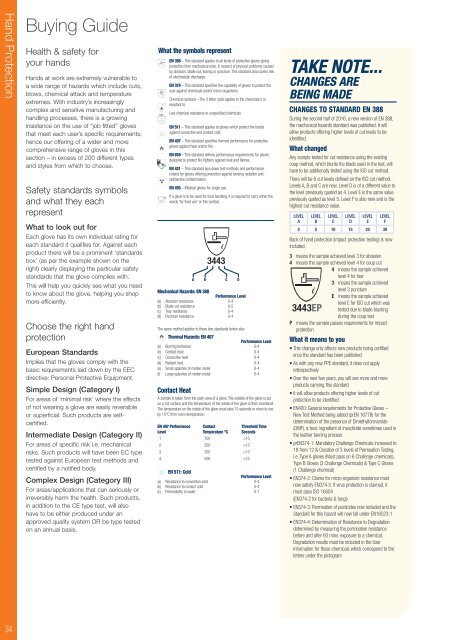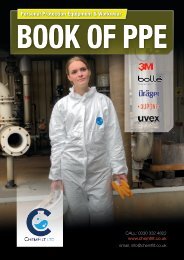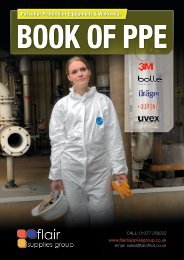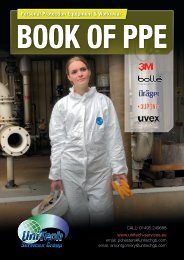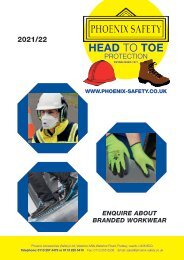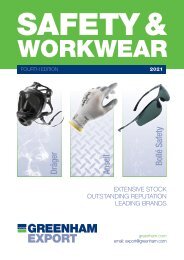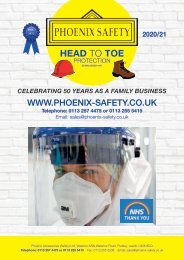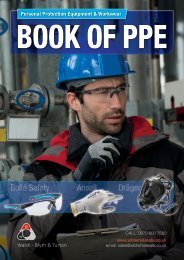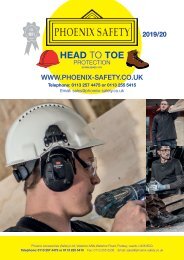You also want an ePaper? Increase the reach of your titles
YUMPU automatically turns print PDFs into web optimized ePapers that Google loves.
Hand Protection<br />
Buying Guide<br />
Health & safety for<br />
your hands<br />
Hands at work are extremely vulnerable to<br />
a wide range of hazards which include cuts,<br />
blows, chemical attack and temperature<br />
extremes. With industry’s increasingly<br />
complex and sensitive manufacturing and<br />
handling processes, there is a growing<br />
insistence on the use of “job fitted” gloves<br />
that meet each user’s specific requirements;<br />
hence our offering of a wider and more<br />
comprehensive range of gloves in this<br />
section – in excess of 200 different types<br />
and styles from which to choose.<br />
<strong>Safety</strong> standards symbols<br />
and what they each<br />
represent<br />
What to look out for<br />
Each glove has its own individual rating for<br />
each standard it qualifies for. Against each<br />
product there will be a prominent ‘standards<br />
box’ (as per the example shown on the<br />
right) clearly displaying the particular safety<br />
standards that the glove complies with.<br />
This will help you quickly see what you need<br />
to know about the glove, helping you shop<br />
more efficiently.<br />
Choose the right hand<br />
protection<br />
European Standards<br />
Implies that the gloves comply with the<br />
basic requirements laid down by the EEC<br />
directive: Personal Protective Equipment.<br />
Simple Design (Category I)<br />
For areas of ‘minimal risk’ where the effects<br />
of not wearing a glove are easily reversible<br />
or superficial. Such products are selfcertified.<br />
Intermediate Design (Category II)<br />
For areas of specific risk i.e. mechanical<br />
risks. Such products will have been EC type<br />
tested against European test methods and<br />
certified by a notified body.<br />
Complex Design (Category III)<br />
For areas/applications that can seriously or<br />
irreversibly harm the health. Such products,<br />
in addition to the CE type test, will also<br />
have to be either produced under an<br />
approved quality system OR be type tested<br />
on an annual basis.<br />
What the symbols represent<br />
EN 388 – This standard applies to all kinds of protective gloves giving<br />
protection from mechanical risks, in respect of physical problems caused<br />
by abrasion, blade cut, tearing or puncture. This standard also covers risk<br />
of electrostatic discharge.<br />
EN 374 – This standard specifies the capability of gloves to protect the<br />
user against chemicals and/or micro-organisms.<br />
Chemical resistant – The 3 letter code applies to the chemicals it is<br />
resistant to.<br />
Low chemical resistance to unspecified chemicals.<br />
EN 511 – This standard applies to gloves which protect the hands<br />
against convective and contact cold.<br />
EN 407 – This standard specifies thermal performance for protective<br />
gloves against heat and/or fire.<br />
EN 659 – This standard defines performance requirements for gloves<br />
designed to protect fire fighters against heat and flames.<br />
EN 421 – This standard lays down test methods and performance<br />
criteria for gloves offering protection against ionising radiation and<br />
radioactive contamination.<br />
EN 455 – Medical gloves for single use.<br />
If a glove is to be used for food handling, it is required to carry either the<br />
words ‘for food use’ or this symbol.<br />
Mechanical Hazards: EN 388<br />
Performance Level<br />
(a) Abrasion resistance 0-4<br />
(b) Blade-cut resistance 0-5<br />
(c) Tear resistance 0-4<br />
(d) Puncture resistance 0-4<br />
The same method applies to these two standards below also.<br />
Thermal Hazards: EN 407<br />
Performance Level<br />
(a) Burning behaviour 0-4<br />
(b) Contact heat 0-4<br />
(c) Convective heat 0-4<br />
(d) Radiant heat 0-4<br />
(e) Small splashes of molten metal 0-4<br />
(f) Large splashes of molten metal 0-4<br />
Contact Heat<br />
A sample is taken from the palm area of a glove. The outside of the glove is put<br />
on a hot surface and the temperature of the inside of the glove is then monitored.<br />
The temperature on the inside of the glove must take 15 seconds or more to rise<br />
by 10°C from room temperature.<br />
EN 407 Performance<br />
Level<br />
3443<br />
A B C D<br />
Contact<br />
Temperature °C<br />
1 100 >15<br />
2 250 >15<br />
3 350 >15<br />
4 500 >15<br />
Threshold Time<br />
Seconds<br />
EN 511: Cold<br />
Performance Level<br />
(a) Resistance to convection cold 0-4<br />
(b) Resistance to contact cold 0-4<br />
(c) Permeability to water 0-1<br />
TAKE NOTE...<br />
CHANGES ARE<br />
BEING MADE<br />
CHANGES TO STANDARD EN 388<br />
During the second half of 2016, a new version of EN 388,<br />
the mechanical hazards standard was published. It will<br />
allow products offering higher levels of cut levels to be<br />
identified.<br />
What changed<br />
Any sample tested for cut resistance using the existing<br />
coup method, which blunts the blade used in the test, will<br />
have to be additionally tested using the ISO cut method.<br />
There will be 6 cut levels defined on the ISO cut method.<br />
Levels A, B and C are new. Level D is of a different value to<br />
the level previously quoted as 4. Level E is the same value<br />
previously quoted as level 5. Level F is also new and is the<br />
highest cut resistance value.<br />
LEVEL<br />
A<br />
LEVEL<br />
B<br />
LEVEL<br />
C<br />
LEVEL<br />
D<br />
LEVEL<br />
E<br />
LEVEL<br />
F<br />
2 5 10 15 22 30<br />
Back of hand protection (impact protection testing) is now<br />
included.<br />
3 means the sample achieved level 3 for abrasion<br />
4 means the sample achieved level 4 for coup cut<br />
4 means the sample achieved<br />
level 4 for tear<br />
3 means the sample achieved<br />
level 3 puncture<br />
E means the sample achieved<br />
level E for ISO cut which was<br />
3443EP tested due to blade blunting<br />
during the coup test<br />
P means the sample passes requirements for impact<br />
protection<br />
What it means to you<br />
• This change only affects new products being certified<br />
once the standard has been published<br />
• As with any new PPE standard, it does not apply<br />
retrospectively<br />
• Over the next few years, you will see more and more<br />
products carrying this standard<br />
• It will allow products offering higher levels of cut<br />
protection to be identified<br />
• EN420: General requirements for Protective Gloves –<br />
New Test Method being added (prEN 16778) for the<br />
determination of the presence of Dimethylformamide<br />
(DMF), a toxic ingredient of insecticide sometimes used in<br />
the leather tanning process<br />
• prEN374-1: Mandatory Challenge Chemicals increased to<br />
18 from 12 & Creation of 3 levels of Permeation Testing,<br />
i.e. Type A gloves (Must pass on 6 Challenge chemicals),<br />
Type B Gloves (3 Challenge Chemicals) & Type C Gloves<br />
(1 Challenge chemical)<br />
• EN374-2: Claims for micro-organism resistance must<br />
now satisfy EN374-5. If virus protection is claimed, it<br />
must pass ISO 16604<br />
(EN374-2 for bacteria & fungi)<br />
• EN374-3: Permeation of pesticides now included and the<br />
Standard for this hazard will now fall under EN16523-1<br />
• EN374-4: Determination of Resistance to Degradation<br />
determined by measuring the permeation resistance<br />
before and after 60 mins. exposure to a chemical.<br />
Degradation results must be included in the User<br />
Information for those chemicals which correspond to the<br />
letters under the pictogram<br />
34


